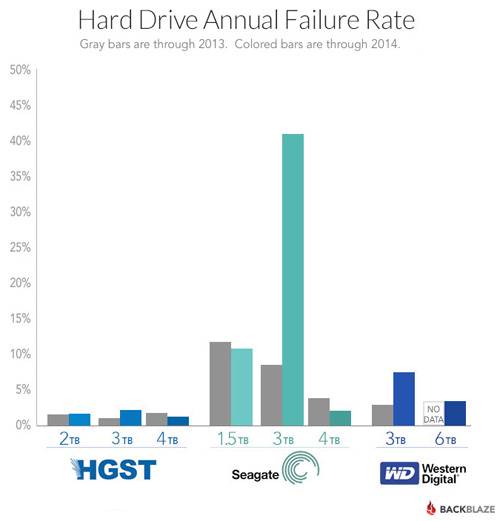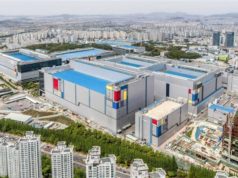When it comes to hard drive reliability, newer 4 TB drives consistently outperform 3 TB models, according to a new study of failure rates from the cloud-based backup provider Backblaze. The review updates a previous examination of hard drive performance conducted by Backblaze a year ago.
Since then, Backblaze has also considerably increased the number of hard drives it runs in its data center. At the end of 2013, it operated 27,134 drives, while it had performance data for 41,213 disk drives by the end of 2014.
Demand for data storage has exploded with the rapid proliferation of smartphones, mobile computing devices and digital devices of all kinds. That is leading to a doubling of digital data every two years, with the world’s total data volume expected to reach 44 trillion gigabytes by 2020, according to EMC’s 2014 Digital Universe study, conducted with analyst firm IDC.
4 TB Drives Performed Best
“All hard drives will eventually fail, but based on our environment if you are looking for good drive at a good value, it’s hard to beat the current crop of 4 TB drives from HGST and Seagate,” Backblaze engineer Brian Beach wrote in a Wednesday blog post.
To get a statistically significant idea of the reliability of the different drives it uses, Backblaze tracked the failure rates of all models in which it had 45 or more units deployed last year. “I chose 45 because that’s the number of drives in a Backblaze Storage Pod and it’s usually enough drives to start getting a meaningful failure rate if they’ve been running for a while,” Beach noted.
The 17 models included in the study ranged from the 4 TB Western Digital, with an average age of 0.8 years and a 0 percent failure rate, and the Seagate 6 TB SATA 3.5, with an average age of 0.4 years and a 0 percent failure rate, to the 3 TB Seagate Barracuda 7200.14, which had an average age of 2.2 years and an annual failure rate of 43.1 percent. Overall, Beach noted, the newer 4 TB models performed the best.
“We like every one of the 4 TB drives we bought this year,” Beach wrote. “For the price, you get a lot of storage, and the drive failure rates have been really low. The Seagate Desktop HDD.15 has had the best price, and we have a lot of them. Over 12 thousand of them. The failure rate is a nice low 2.6 percent per year. Low price and reliability is good for business.”
Although they’re priced a little higher, the HGST drives have an even lower failure rate, at 1.4 percent, he said. “It’s not enough of a difference to be a big factor in our purchasing, but when there’s a good price, we grab some. We have over 12 thousand of these drives,” Beach added.
Maturing Market Brings Stability
We reached out to John Rydning, IDC’s Research Vice President of Hard Disk Drives and Semiconductors, to learn more about what he’s seeing in the marketplace.
While IDC doesn’t specifically monitor failure rates, anecdotal evidence from clients shows that hard disk drives generally go through several stages of reliability, Rydning said. In the first 18 months or so, failure rates tend to be a bit higher. After that, performance stabilizes for a long period of time until about the three-year mark, when wear and tear start to lead to rising failure rates, he said.
In general, reliability has also stabilized as the market has matured. More models were released more frequently 10 or 15 years ago, while the trend over the past five years or so has been for fewer models to come out as fewer innovations are made to the drives, he said.
Rydning added that he expected that trend to continue to hold for the next five years or so, meaning that “customers are going to generally see better reliability.”






![[CES 2026] Quest For Perfect Color…Samsung To Push](https://loginby.com/itnews/wp-content/uploads/2025/12/CES-2026-Quest-For-Perfect-Color…Samsung-To-Push-100x75.jpg)
